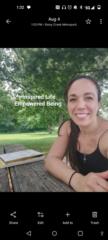Activity
Mon
Wed
Fri
Sun
Jan
Feb
Mar
Apr
May
Jun
Jul
Aug
Sep
Oct
Nov
Dec
What is this?
Less
More
Memberships
Inspired Life, Empowered Being
89 members • Free
Younity România
7.5k members • Free
13 contributions to Inspired Life, Empowered Being
Your Higher Self Has a Better Seat-Go Sit There (The Balcony View)
The Balcony View-Gaining Perspective Without Disconnecting The "balcony view" is a psychological skill that often gets overlooked and is underutilized IMHO, yet it can change the entire tone of how we respond to stress and heightened emotion situations. Instead of getting swept up in the heat of the moment, this is an opportunity to mentally step up to a higher perspective and look at the situation like you are watching it unfold from above. This creates just enough distance to think more clearly. Nerd Alert (some science behind it): The balcony view works because it activates metacognition (awareness of our own thoughts/thinking) and recruits areas of the prefrontal cortex that support reflection, emotional regulation, and decision making. The ventromedial prefrontal cortex calms the fear (fight/flight/freeze/fawn ) response. The anterior cingulate cortex helps shift attention so you can see the bigger picture instead of fixating on the trigger. This is very different from dissociation. Dissociation pulls you into fog and detachment. The balcony view pulls you into clarity and a level of control/intentionality. It's a strategic shift so that emotions are there to inform but not to be in the driver's seat. It's a way to increase emotional intelligence and when engaged it has the potential to diffuse heightened situations. How to do it: To practice it, take a deep breath and pause before reacting Imagine yourself taking a few mental steps upward (as if climbing to get the balcony view of a play) and then watch the scene as if it were happening on a stage. Notice the facts, the emotions, and the choices available. No judgment--if there are judgments, notice them as such. The point of this is to just observe the situation and gather information. The more you use it, the easier it becomes to respond with clarity instead of impulse. (and a resource on processing emotions :) ). What are your strategies for making space for and honoring your emotions but not letting them rule in a conflict?
Thank you.😭
Hello beautiful souls, I just wanted to thank you all for being here, for engaging, for supporting me and each other, for your presence.... As many of you know, when I started this skooling journey, I didn't anticipate (or have many thoughts) for the community aspect of this--just wanted a creative outlet and a place for resources and if people joined, that would be a plus... I am SO incredibly thankful that the community piece has shown up and has grown in the way that it has. It was a gift that I didn't realize that I needed and I really really hope that it continues! You have added so much to my life. There have been friendships that have been forged or further nurtured and it's so beautiful to see everyone interact. I am so so truly thankful. I don't know how to express that in a way where the depth of what I'm saying and the emotion behind it can land, but I hope you know how valued you truly. are. I really wanted to go through each person individually and write something to /about them, but that would be a very very very long post...But please know that I am truly thankful. Your kindness, your vulnerability, your compassion, your courage, your presence---all of it --is so appreciated. :) Happy Thanksgiving for those who celebrate! All my love, Georgiana
🧠 Confirmation Bias: Seeing What We Want to See 🧠
We all carry biases in life. It's helpful to know what they are. But today we'll focus on confirmation bias, one of the most commonn logical fallacies. Definition:"the tendency to interpret new evidence as confirmation of one's existing beliefs or theories" It happens when we focus on information that supports our existing beliefs while ignoring or discounting evidence that challenges them. We also take neutral input as something favoring 'our' side. **We give special weight to information that allows us to come to the conclusion that we want to reach** This mental shortcut feels comfortable but can lead to distorted thinking, poor decisions, and missed opportunities for growth. ✨ What It Looks Like in Real Life - 📰 News Consumption: Only reading articles or following social media accounts that agree with your views or discounting opposing/differing views. - 💬 Conversations: Seeking out people who validate your opinions while avoiding those who disagree. - 🔍 Decision Making: Interpreting neutral evidence as proof you were “right all along.” Why Confirmation Bias Happens - We dislike cognitive dissonance—holding beliefs that are challenged causes discomfort, so we avoid it. - Beliefs feel more certain because we’ve already invested trust or identity in them. Letting them go feels like loss. (Remember the sunk cost fallacy from earlier? This definitely plays into this!) - We often have selective exposure: we choose what to read, who to listen to, what to trust—allowing bias to reinforce itself.--the bubble effect/echo chamber effect is real here. 🎯 Why It Matters When we only see what confirms our beliefs, we risk reinforcing biases, polarizing relationships, and making errors in judgment. Studies show that confirmation bias can strengthen false beliefs over time, making it harder to change our minds. 🌱 How to Break Free from Confirmation Bias 1️⃣ Actively Seek Opposing Views: Read or listen to perspectives different from your own. ALL change begins with being honest! 1--be aware of the biases you may have and 2--be OPEN to being proven wrong (intellectual humility is a flex! Use it!)
4 likes • Sep 25
Hello! Excellent material! I will introduce it to seminars with students. Already, since 2019, I have introduced the obligation to process a news item from the media. The processing process contains 6 steps. Following the processing, the student must come to the conclusion whether it is a true or false news item, or a distortion, a truncation of the original news item or a removal from context. The material posted by you will bring added value to the reception of news. Thank you!
Favorite books or current reads!
I'd love to get a list going of people's favorite books or current reads! (or if you've written a book yourself, feel free to share that as well!). If you'd be so inclined, please feel free to share in this space. Also, if there's a book you would NOT recommend, share that too. I'm curious! My current reads: The Bible-trying to make this a daily habit Podvig Catch-22 Why the kids aren't growing up Soundtracks People of the Lie Thinking Fast and Slow Pissed Off With a Purpose: Waging War on Fear My most recent reads: An Arsenal of Gratitude-Waging War on Mediocrity and Regret (shoutout to @Dan 'Remmy' Stourac --it's written by him and it's amazing!!). Dune Crazy busy The Great Alone In the Realm of Hungry Ghosts: Close Encounters with Addictions Fight Club Scattered Minds: The Origins and Healing of Attention Deficit Disorder Disappointment with God Kasher in the Rye (NOT to be confused with Catcher in the Rye) Favorite Books: Man's Search for meaning-viktor frankl Elements-Transfiguration of Elijah -anonymous priest in the oriental orthodox church Daring Greatly (and a bunch of Brene Brown's other work--Gifts of Imperfection; I thought it was just me but it wasn't; Braving the Wilderness) Screwtape Letters and the Great Divorce by C.S. Lewis Atomic Habits Brother's Karamazov and Crime and Punishment by Dostoevsky Welcome to the Orthodox Church by Fredericka Matthews Greene (I'll continue adding, these are just top of mind right now! ) Thank you for the inspiration @Dan 'Remmy' Stourac Please add to the list: @Aleksandra Nedelkoski @Anastasia Cocioaba @Andres Mateo @George Arhip @Loren Angelo @Britni Burton @Tim Blacke @Christa Lovas @Anastasia Cocioaba @LaTanya Carter @Dan 'Remmy' Stourac @David Pepper @David Pepper @Dayna Kanouna @Dr. Melissa Partaka @John D @Rachel Featherstone @Julia Groth @William Guy @Kimberly Poirier @Lisa Papiez @Lisa Vanderveen @Mary Seguin @Michael Mcknight @Michelle Mann @Moni Matysiak @Rina Maniou @Ronnie McCabe @Peter Oconnell @Ruth aka Grace Rose @Ryanne Ryan @Tracy Stewart @Adriana Filip @Jennifer Chatle @Anna Lh @Brittany Hone @Chris Wendt @Jose Colon @Yvonne Green @Linda Short @Nicole Johnson @Julie Nelson @Stephanie Riley @Tharuk M @Vasi Smith @Wesley Penner @Chris Wendt
7 likes • Sep 25
Hello! I recommend the following books: Daniel J. Siegel, The Mindful Brain. Reflections and Attunement in the Cultivation of Well-Being; Roy F. Baumeister, Meanings of Life; Daniel Goleman, Destructive Emotions. How Can We Overcome Them?; T.J. Power, The DOSE Effect; Kevin Dutton, The Wisdom of Psychopaths. Lessons in Life from Saints, Spies and Serial Killers. These are just a few, for now. I will come back with reading recommendations.
🧘♀️ Meditation: Safe Haven or Dangerous Battleground?
In its simplest definition, meditation is a practice that involves focusing or clearing your mind using a combination of mental and physical techniques. Meditation is often praised for peace, clarity, stress relief, spiritual growth... BUT, what happens when that's not the experience? Many people don’t expect the unusual, scary, or even supernatural-type experiences that can emerge when they meditate deeply or intensely. We "clear our minds", but what is it that we're leaving room for? What is that space being filled with? **About 33% of people indicate experiencing negative/adverse effects with meditative practice* This is considered a statistically significant number** (JUMP to the bottom for positive/negative experiences surrounding this) Meditation was initially a religious practice but has made ground with individuals that don't consider themselves religious. It can be found across cultures and religions and dates back for thousand of years. 🙏Examples of Meditation in different religions/cultures/contexts: - Buddhist: Several different forms of meditation have their origins in Buddhism (which is considered both a philosophy and a religion, especially depending on the nation of origin). Theravadan meditation is more common in Southeast Asia, especially in India and Thailand. Zen Buddhist meditation originated in China, and different forms of it eventually evolved elsewhere, such as Japanese Zen Buddhist meditation. Tibetan Buddhist tantric meditation comes from the former nation of Tibet, now a region of China. Buddhism emphasizes mindfulness and insight to cultivate compassion and liberate from suffering. - Christian: Contemplation or contemplative prayer is a common practice in Christianity. Praying is often classified as meditation. *A note here: may be worth looking into the different Christian groups and their view/stance on meditation. - Islam: uses shikr (rememberance of God) and muraqabah (meditative reflection) for spiritual closeness - Judaism: offers meditation-like practices such as hitbodedut and Kabbalistic contemplation to deepen connection with the divine. - Guided: A nonreligious form of meditation can happen with several people or one-on-one. It’s a common technique in counseling, therapy and group support settings. - Osho: This form of meditation, also known as “dynamic meditation”, comes from India and has its roots in Hinduism. Breathing exercises are deliberate and forceful. - Sufi: Sufism is a branch of Islam, and meditation is a common practice among people who follow it. - Taoist: Like Buddhism, Taoism is also considered a religion and philosophy. It originated in China and is best known through the writings of its founder, Laozi (also spelled “Lao Tzu” or “Lao-Tze”). - Transcendental : This form of meditation comes from India. It involves using mantras, which are phrases or words people focus on and repeat aloud or in their minds. - Yoga: This is a physical form of meditation and exercise from India. It can take on religious and nonreligious forms.
2 likes • Sep 25
In 2011, I discovered a hypnotic induction script in the book by Areed Barabasz and John G. Watkins, Hypnotherspeutic techniques. The script is inspired by Taoist meditation. The main purpose of this meditation is to bring balance to the functioning of the body and mind. I adapted that script for various psychosomatic conditions, and patients who seriously practiced the meditation exercise (delivered as an audio recording, with my voice) achieved remarkable results, some even spectacular, when they no longer saw any chance.
1-10 of 13


